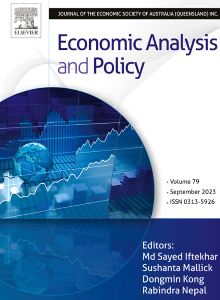缓解供应链中的气候风险:来自中国企业牛鞭效应的实证分析
IF 8.7
2区 经济学
Q1 ECONOMICS
引用次数: 0
摘要
企业供应链管理越来越强调适应能力和弹性,以应对日益增长的气候风险。本研究考察了气候风险暴露如何影响企业缓解供应链牛鞭效应的能力。利用中国a股上市公司2007-2022年的数据,通过对年报的文本分析,构建了气候风险暴露指数。研究结果表明,气候风险敞口较大的企业积极减少牛鞭效应,提高供应链稳定性。推动这种改进的关键机制包括库存优化、数字化转型和供应链集中度的提高。异质性分析表明,资源优势企业和处于竞争行业的企业受益更显著。此外,气候风险的影响各不相同:极端风险加剧供需失衡,慢性风险提高长期供应链弹性,转型风险表现出延迟效应。这些见解强调了企业如何调整其供应链战略以适应气候风险,在面临日益增加的环境不确定性时促进运营稳定性和弹性。本文章由计算机程序翻译,如有差异,请以英文原文为准。
Mitigating climate risk in supply chains: Empirical insights from the bullwhip effect in Chinese enterprises
Corporate supply chain management increasingly emphasizes adaptability and resilience in response to growing climate risks. This study examines how climate risk exposure influences firms’ ability to mitigate the bullwhip effect in supply chain. Using data from Chinese A-share listed firms (2007–2022), a climate risk exposure index is constructed through textual analysis of annual reports. The findings reveal that firms with greater climate risk exposure actively reduce the bullwhip effect, enhancing supply chain stability. Key mechanisms driving this improvement include inventory optimization, digital transformation, and increased supply chain concentration. Heterogeneity analysis shows that resource-advantaged firms and those in competitive industries benefit more significantly. Additionally, the impact of climate risks varies: while extreme risks intensify supply-demand imbalances, chronic risks improve long-term supply chain resilience, and transition risks exhibit delayed effects. These insights highlight how firms adapt their supply chain strategies to climate risks, promoting operational stability and resilience in the face of increasing environmental uncertainties.
求助全文
通过发布文献求助,成功后即可免费获取论文全文。
去求助
来源期刊

Economic Analysis and Policy
ECONOMICS-
CiteScore
9.80
自引率
9.20%
发文量
231
审稿时长
93 days
期刊介绍:
Economic Analysis and Policy (established 1970) publishes articles from all branches of economics with a particular focus on research, theoretical and applied, which has strong policy relevance. The journal also publishes survey articles and empirical replications on key policy issues. Authors are expected to highlight the main insights in a non-technical introduction and in the conclusion.
 求助内容:
求助内容: 应助结果提醒方式:
应助结果提醒方式:


